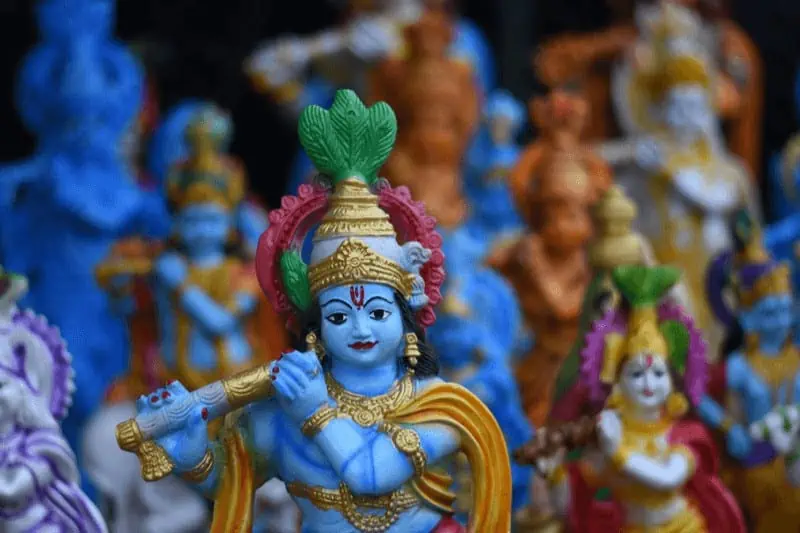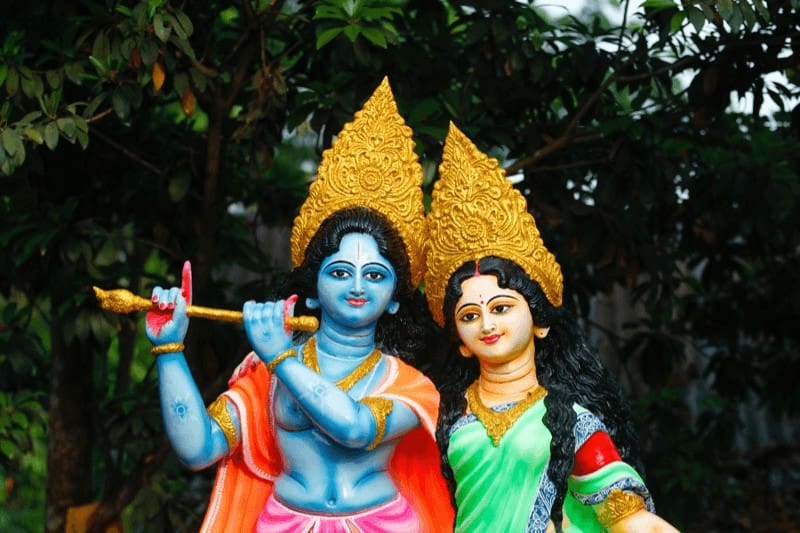Folks select to start a yoga observe for any variety of causes: enhancing bodily well being and suppleness or managing stress, for instance. That was the case for me earlier than turning into a yoga instructor.
Over time, nonetheless, my observe developed into one thing extra — I started practising yoga for the enjoyment I felt by coming to my mat every day, whereas the bodily advantages grew to become a secondary perk.
Whenever you undertake this devotional perspective in direction of yoga, you might be practising Bhakti Yoga, a standard path of yoga that emphasizes love and devotion.
This divine observe transcends the bodily asana (postures) most individuals use to outline yoga. As a substitute, it illuminates the way in which towards a deeper reference to the self, the universe, and God. And the most effective factor about it? You don’t want the superior information of a yoga scholar to observe Bhakti Yoga.
Much less Asana, Extra “A-U-M”
Reasonably than following a standardized sequence of yoga postures with particular alignment requiring the supervision of a yoga instructor, Bhakti Yoga is a extra private, religious observe. You want nothing greater than a real want to acknowledge the sacred and divine that means in your life.
Now, you have to be curious concerning the whys and hows of Bhakti Yoga — particularly, why do you have to incorporate Bhakti practices into your yoga routine (quick reply: as a result of who doesn’t want a bit extra grace and pleasure of their life?), and how do you go about it? (Spoiler alert: it’s simpler than you assume)!
Learn on to find how Bhakti practices can remodel and add that means to your yoga, work, and all areas of your life. Step as much as the altar, fellow yogi, and let’s uncover collectively what the Bhakti path is all about!
Origin and Historical past of Bhakti Yoga
Bhakti Yoga is an historical observe centered on love and devotion to a private god or the divine. The title “Bhakti” comes from the Sanskrit root phrase “bhaj,” which implies “to serve” or “to worship.”
Bhakti Yoga goals to construct a loving, devoted relationship with a deity with the final word purpose of religious enlightenment. Its numerous rituals and practices deepen the emotional connection to 1’s personal divine mild and supreme actuality, or God.
The Bhagavad Gita, one of the vital sacred texts of Hinduism, consists of Bhakti Yoga as one of many 4 most important paths in classical yoga. These paths embrace Bhakti (the trail of devotion), Karma Yoga (the trail of motion), Jnana Yoga (the trail of data), and Raja Yoga (the royal path of meditation).
Defining the Bhakti Path
Within the historical Hindu textual content, the Bhagavad Gita, Lord Krishna teaches concerning the energy of devotion. It is a core precept of Hinduism referred to as the bhakti path. Different important teachings from this sacred e book embrace:
- Give up: Practitioners ought to provide their love and repair to a private god with out reservation, surrendering their will with unwavering religion within the divine.
- Centered dedication: By concentrating the thoughts and coronary heart solely on a selected deity, followers of Bhakti yoga can transcend actuality and attain religious enlightenment.
- Acceptance: Krishna explains that Bhakti Yoga is a common religious path accessible to anybody no matter social class, standing, or gender.
The last word purpose of Bhakti yoga is to realize religious liberation (moksha) by means of selfless love and repair to the divine.
Enlargement of Bhakti Over Time
Over the next centuries, Bhakti yoga developed and unfold step by step, with many yoga students contributing to Bhakti literature and practices.
The Puranas are one other group of sacred texts in Hinduism containing tales, myths, and non secular teachings related to particular deities. Together with Krishna, there are puranas dedicated to Lord Shiva and Vishnu, in addition to Devi, the divine mom goddess.
Bhakti practitioners discover inspiration on this assortment of texts, crammed with hymns, prayers, and philosophical insights, to worship their private god or chosen deity.
Connection to the Arts
Poetry and music performed a vital function in spreading the essence of Bhakti Yoga.
- Alvars and Nayanars: Two teams of poet-saints within the Sixth-Eighth centuries CE who composed devotional hymns and songs to Lord Vishnu and Shiva
- Akka Mahadevi: A Twelfth-century poet who wrote devotional songs expressing her love for Lord Shiva.
Not like many conventional mantras that use Sanskrit phrases, composers of Bhakti poetry and songs wrote them within the on a regular basis language of their area and occasions, making their message accessible to a broad viewers.
Interfaith Overlap
The origins of Bhakti Yoga lie in Hinduism. But, it shares similarities with many devotional practices of different religious traditions.
| Faith | Custom(s) shared with Bhakti Yoga |
| Christianity | prayer, singing of hymns, particular person relationship with and worship of a private god or savior |
| Judaism | conventional ceremonies that embrace collective chanting and singing of sacred hymns, emphasis on loving and private reference to God |
| Sikhism | devotional singing and worship of 1 God |
| Sufism | emphasis on divine love, chanting, and singing as types of worship |
| Buddhism | meditation, deep contemplation, mantra chanting, performing acts of service, purpose of accomplishing a state of bliss |
Krishna Consciousness Motion
Lord Krishna is a deity worshipped in Hinduism who is commonly related to love, divine pleasure, and, in fact, Bhakti yoga.
A distinguished trendy type of Bhakti Yoga is devoted to Krishna himself. The Krishna Consciousness Motion, or Worldwide Society for Krishna Consciousness, was based in 1966 in New York and is kind of influential in preserving custom and sharing the knowledge of the Bhakti approach.
Followers of this motion think about Krishna to be the Supreme Being and supply of all creation. He’s a task mannequin for his devotees, referred to as Hare Krishnas, as they attempt to embody his supreme qualities of compassion, grace, love, and knowledge.

Core Precept: The Devotional Angle of Bhakti Yoga
Bhakti Yoga is about devotion, proven by means of practices comparable to chanting and meditation. This type of yoga emphasizes give up to the next energy for self-realization and internal peace.
Expressing Devotion Via Numerous Practices
Not like different types of yoga, Bhakti is much less about practising asana (postures) and extra about kindling the divine mild inside. What ignites one particular person’s coronary heart and soul with pleasure might differ from individual to individual. Fortunately, in Bhakti yoga, there are a variety of how to specific your devotion.
- Mantras, or sacred chants, are sometimes used to invoke divine love. Some would possibly chant the names of Lord Krishna or Vishnu, whereas others might desire completely different deities.
- Prayer and meditation additionally play vital roles. These practices enable devotees to attach with their private god or goddess.
- Constructing a easy altar or sacred house within the residence in honor of a deity is one other approach devotees can observe Bhakti.

Surrendering to a Larger Energy
In Bhakti Yoga, give up isn’t an indication of weak spot; it’s an act of religion. The custom teaches that by surrendering our ego to the next energy – be it a private god or goddess or any deity – we will expertise divine mild inside ourselves, the union of Atman (the soul) with God.
The Path to Self-Realization
The Bhakti path isn’t about reaching an exterior vacation spot; it’s about touring inward and connecting to the divine mild inside us. The concept is that incorporating sacred practices into day-to-day life allows one to see the divine in the whole lot round them. Devotees of Bhakti yoga imagine this final purpose brings internal peace and divine bliss.
Levels of Devotion in Bhakti Yoga
Aparabhakti and Parabhakti
The religious observe of Bhakti Yoga begins with aparabhakti. This stage is about exterior motion. It’s the start of the Bhakti path, the place devotees present love in direction of deities by means of rituals and ceremonies.
Then comes parabhakti. This greater section is all about inner worship. Right here, there may be much less emphasis on ritual because the devotee can categorical their love and devotion by means of each motion they take.
9 Levels of Devotion
In accordance with sacred Bhakti texts, there are 9 levels of devotion. Every stage builds upon the one earlier than it till one reaches the ultimate section of full give up to the divine.
- Shravanam: Listening to tales about God.
- Kirtanam: Singing or chanting God’s title.
- Smaranam: Remembering God always.
- Padasevanam: Serving God’s toes (a metaphor for service).
- Archana: Worshiping a picture or icon of God.
- Vandanam: Providing prayer to God.
- Dasya: Changing into a servant of God.
- Sakhya: Creating friendship with God.
- Atmanivedana: Full give up to God.
Every stage takes the devotee deeper into their religious journey, fostering a stronger bond with the divine.
The Function of Guru
To progress on the religious path, a devotee wants steerage from a guru or instructor. The guru helps the devotee domesticate a devotional perspective and transfer by means of the levels from aparabhakti to parabhakti.
Within the Bhagavad Gita, Krishna speaks to the significance of in search of instruction and perception from a certified instructor. In accordance with Krishna, the function of the guru consists of:
- Steerage and knowledge: As a supply of divine information, the guru helps their pupil deepen their understanding of Bhakti, final actuality, and enlightenment.
- Preserving custom: The guru-student relationship is important for passing down sacred information, traditions, and Bhakti practices from one technology to the subsequent.
- Self-discipline in observe: In following the instance of their guru, the coed develops consistency and self-discipline of their Bhakti observe. Moreover, providing service and obedience to a guru is a type of give up, a core facet of Bhakti yoga.
Strategies and Practices in Bhakti Yoga

Commonplace Practices of Bhakti Yoga
Bhakti yoga includes a number of practices. These embrace mantra repetition, visualization, and ritual worship.
- Mantra repetition is chanting sacred phrases or phrases, typically utilizing musical devices. It’s like a religious jam session!
- Meditation: A observe the place a person makes use of a method or path to attain psychological readability.
- Visualization includes picturing divine entities. Consider it as daydreaming with a holy twist.
- Ritual worship respects the divine by means of ceremonies, comparable to prayer conferences or group discussions of spiritual texts and teachings.
Paths inside Bhakti Yoga
There are completely different paths in bhakti yoga, too. Every path gives its distinctive technique to join with the divine.
- Shanta (Peaceable Love) is all about calmness, bringing a way of tranquility into one’s reference to God.
- Dasya (Servitude) focuses on serving the divine.
- Sakhya (Friendship) promotes forming an expensive friendship with God.
- Vatsalya (Parental Love) encourages treating the divine like your youngster, exhibiting love by means of care and safety.
- Madhura (Conjugal love) fosters romantic emotions in direction of the divine, treating your private god as you’d the one you love.
Every path has its traditions and mantras that practitioners observe. Bhakti devotees might select the way in which they categorical their love for God in a approach that fits their particular person preferences and private religious observe.
Reference to The Divine
These strategies assist foster a deep reference to the divine. They allow you to really feel nearer to God, whoever you understand them to be.
As an example, mantra repetition could make you are feeling such as you’re conversing with God. Visualization can create a picture of divinity in your thoughts’s eye.
The completely different paths provide numerous methods to narrate to the divine. All of us have one thing we will relate to, like serving to others, friendship, or love from household and companions.
Function of Kirtan and Archana in Bhakti Yoga

Bhakti Yoga is all about devotion. Two vital elements of this are Kirtan and Archana.
What’s Kirtan?
Kirtan, by definition, is communal singing or chanting, usually with music thrown in. That is completely different out of your typical choir observe, although! The melodies and rhythms will be easy or complicated, however they’re all the time highly effective.
Give it some thought – while you’re belting out your favourite tune with others, don’t you are feeling a way of unity? That’s the ability of Kirtan — the ability of many voices coming collectively intensifies and deepens the religious expertise.
Archana: Intentional Actions
Now, let’s discuss Archana. That is ritualistic worship, the place devotees make choices to deities. These choices might be flowers, meals, incense – something that exhibits respect and devotion.
It would sound fancy, however it’s fairly simple. Arrange a easy altar, mild a stick of incense or a candle, and there you go! You’re simply exhibiting some like to the divine by means of these gestures.
Why Kirtan and Archana Matter
So what’s so particular about Kirtan and Archana in Bhakti Yoga? Why have these traditions endured for hundreds of years?
Effectively, they assist domesticate devotion and group spirit. When folks come collectively to chant or make choices, this shared love and respect for the divine multiplies. It’s like being a part of a crew the place everybody’s working in direction of the identical purpose.
And hey, trendy science backs this up, too! Analysis has discovered that collaborating in group actions like Kirtan — in individual or on-line — can enhance social connection and emotional well-being.
So there you’ve gotten it – these traditions of Kirtan and Archana have stood the check of time and are nonetheless related in modern-day Bhakti Yoga practices. They’re extra than simply rituals; they provide technique of constructing group spirit and fostering devotion.
Any exercise that brings folks collectively, encouraging love, pleasure, and togetherness, is actually great! Don’t you agree?
Advantages and Influence of Bhakti Yoga
Bodily Perks
Now, you is likely to be questioning, since there may be much less emphasis on bodily asana in bhakti yoga — are there bodily advantages to the observe?
This type of yoga generally is a actual game-changer to your physique. It helps cut back stress and decrease blood strain, vital points in at present’s fast-paced world. Plus, constant Bhakti observe improves focus by means of meditation and focus.
So, the bodily perks of Bhakti yoga won’t be noticeable from the surface of your physique, however you’ll really feel a distinction internally in your coronary heart and thoughts!
Emotional Boosts
However wait, there’s extra! Bhakti yoga isn’t simply good to your physique; it additionally boosts your feelings. Incorporating devotional practices like prayer or chanting mantras every day will increase compassion and helps temper stability.
Fashionable science backs these constructive results:
- In one examine, adults with persistent psychological well being points who participated in choir singing and inventive writing (for instance, writing poetry) skilled a neater time regulating their feelings.
- One other examine reported that after a three-month Bhakti Yoga intervention, contributors skilled diminished anxiousness and fewer signs of despair.
This scientific proof reinforces why these practices have caught round for therefore lengthy — they work!
Religious Development
Right here’s the place Bhakti yoga shines — the religious advantages. It takes you on a journey in direction of heightened self-awareness. You get to know your self higher than ever earlier than.
It deepens your understanding of divine love and reference to God or your greater energy, resulting in religious development.
And the most effective half? It’s utterly customizable: the way you observe Bhakti, the traditions you observe, and the deities you worship are all as much as you. It’s a person religious observe that may take many types. That is what makes Bhakti yoga genuinely distinctive and highly effective.
Embracing Bhakti Yoga Observe
Bhakti Yoga is a singular path to religious enlightenment. It has a wealthy historical past and profound ideas of devotion. This observe helps you develop and perceive your self by specializing in love, religion, and give up.
The varied levels of devotion in Bhakti Yoga provide practitioners construction for deepening their religious journey. Kirtan and Archana play vital roles on this observe, enhancing the expertise by means of music and communal worship. The advantages of Bhakti Yoga aren’t restricted to religious development alone; additionally they lengthen to psychological and emotional well-being.

Suggestions for Starting a Bhakti Yoga Observe
So, are you curious about exploring Bhakti Yoga however not sure the place to begin? Listed below are some concepts to get you going!
- Spend a while studying concerning the deities in Hinduism and think about which private god or goddess you would possibly take pleasure in devoting your observe to. Shiva and Vishnu are widespread decisions, however you possibly can select one which resonates with you!
- Create a small altar in your house with a photograph of your chosen deity. Take a little bit of time every day to mild a candle or incense stick and say a prayer of gratitude to the divine.
- Test your native space for temples or yoga studios that supply group mantra chanting periods. Keep in mind, these could also be accessible on-line as nicely!
- Grow to be a Bhakti yoga scholar by studying a traditional textual content, like this Bhagavad Purana e book.
Participating in Bhakti Yoga can result in transformative experiences that enrich life on many ranges. We invite you to discover this historical observe additional and uncover the way it may help you navigate your religious journey.
Keep in mind that each step towards self-discovery is a step towards better peace and achievement.
FAQ 1: What’s the most important focus of Bhakti Yoga?
The primary focus of Bhakti Yoga is devotion or love in direction of the next energy or divine entity. It emphasizes emotional engagement over bodily postures.
FAQ 2: How does Kirtan contribute to Bhakti Yoga?
Kirtan is a central observe in Bhakti Yoga. Devotees collect to chant mantras or sing hymns, which helps deepen the sense of devotion and reference to the divine.
FAQ 3: Can rookies begin with Bhakti Yoga?
Sure, rookies can begin with Bhakti Yoga. Its emphasis on love and devotion makes it accessible for people in any respect ranges of yoga expertise. You want no prior expertise, however discovering a bunch or instructor to information you at the start of your Bhakti journey is useful.
FAQ 4: What are some advantages of practising Bhakti Yoga?
Practising Bhakti Yoga can result in elevated peace, diminished stress ranges, improved emotional well-being, better compassion, enhanced sense of objective, and deeper religious understanding.
FAQ 5: Does Bhakti Yoga emphasize a selected non secular perception?
No, Bhakti Yoga doesn’t promote adherence to a selected faith. It’s about cultivating love and devotion, which you’ll be able to direct in direction of any divine entity or greater energy you imagine in.

